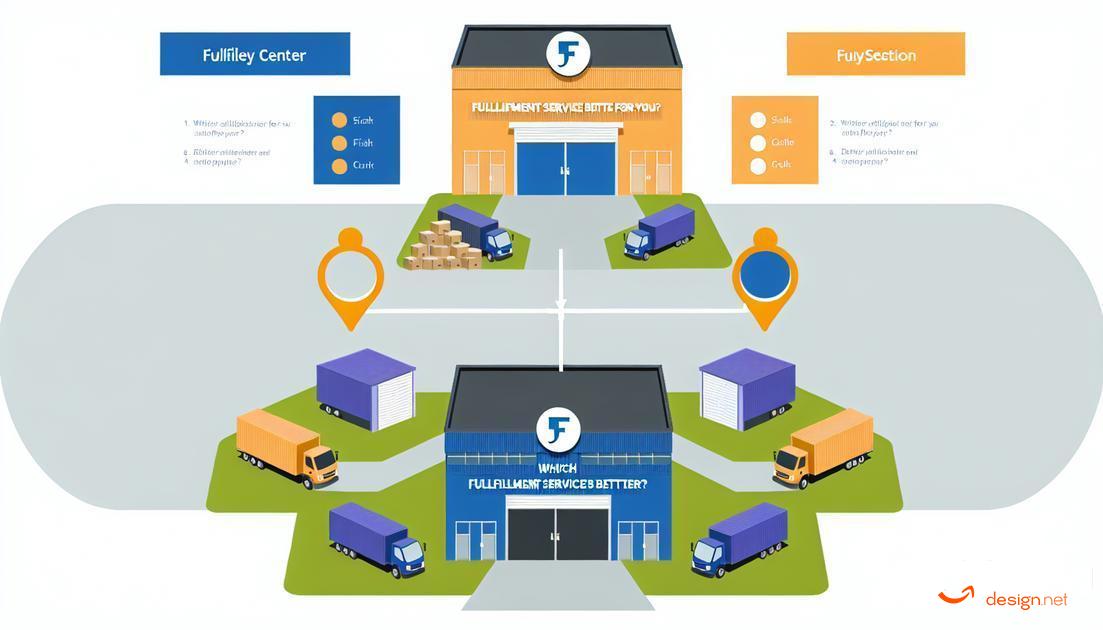Choosing the right fulfillment service is crucial for your business. Two popular options are Walmart WFS and Amazon FBA. This article will provide an in-depth comparison to help you decide which is best for your needs. We’ll cover key aspects, benefits, and limitations of both services.
Table of Contents
Overview of Walmart WFS
Walmart Fulfillment Services (WFS) is a comprehensive fulfillment program designed to help sellers store, pick, pack, and ship their products with ease. As a seller, you can leverage Walmart’s extensive logistics network to manage your inventory and ensure fast delivery to customers.
When you use WFS, your products are eligible for TwoDay Delivery to many locations across the United States, enhancing your visibility and appeal to Walmart’s large customer base. Orders are processed quickly, with Walmart’s reliable shipping services ensuring that items reach customers within the promised timeframe.
One of the major benefits of WFS is its handling of customer service on your behalf. Walmart’s customer care team manages all inquiries, returns, and refunds associated with orders fulfilled by WFS, allowing you to focus on other aspects of your business.
WFS also offers a user-friendly interface within the Walmart Seller Center, providing detailed analytics and reports on your sales and inventory levels. This transparency enables you to make informed decisions and optimize your operations effectively.
Overview of Amazon FBA

Amazon FBA (Fulfillment by Amazon) offers sellers a comprehensive solution for order fulfillment. Amazon’s massive network ensures that products reach customers quickly through their extensive logistics system. Sellers send their inventory to Amazon’s fulfillment centers where items are stored, picked, packed, and shipped directly to customers.
Benefits include:
- Access to Amazon Prime: Products fulfilled by FBA are eligible for Amazon Prime, attracting millions of loyal customers who prioritize fast and free shipping.
- Scalability: Amazon handles all aspects of order fulfillment, allowing sellers to scale their business without the constraints of managing inventory and logistics.
- Customer Support: Amazon FBA provides round-the-clock customer service, including handling returns and refunds, alleviating sellers from these tasks.
Additionally, Amazon’s sophisticated inventory management tools help sellers track and manage stock levels efficiently. The service also offers multichannel fulfillment where sellers can fulfill orders from other sales channels such as Shopify, eBay, and Walmart using Amazon’s fulfillment network.
However, sellers need to consider the associated fees, including storage, fulfillment, and additional service fees. Understanding these costs is crucial for evaluating profitability and pricing strategies. Consistent monitoring and analyzing performance through Amazon’s detailed sales reports can help in optimizing the use of FBA services.
Key Differences Between Walmart WFS and Amazon FBA
Marketplace Exposure: Walmart WFS leverages Walmart.com’s immense customer base, while Amazon FBA taps into the extensive reach of Amazon.com. Both offer vast audiences but differ in market dynamics and customer shopping behavior.,Listing and Fulfilment Fees: The fee structures for Walmart WFS and Amazon FBA vary significantly. While Amazon FBA charges fees based on categories and size tiers, Walmart WFS bases its fees on simpler per-unit charges, which might be more predictable for sellers.,Seller Central Platforms: Amazon FBA uses Seller Central, a robust platform with extensive tools and analytics. Walmart WFS has its own Seller Center, which is user-friendly but might lack some advanced features found in Amazon’s interface.,Logistics and Warehousing: Both services provide comprehensive warehousing solutions. However, Amazon FBA has a more extensive network of fulfillment centers, which may facilitate faster delivery times in more regions.,Returns and Customer Service: Amazon FBA handles customer service and returns efficiently due to its well-established processes. Walmart WFS also manages returns and customer service but is consistently evolving to match Amazon’s level of service.,Onboarding and Account Health: Amazon FBA has stringent onboarding and performance metrics. Walmart WFS, while also having high standards, may be perceived as slightly less demanding, giving new sellers more initial flexibility.,International Reach: Amazon FBA offers extensive international shipping options and global marketplaces integration. Walmart WFS is primarily focused on the U.S. market, which might limit international expansion opportunities for sellers.
Cost Comparison: Walmart WFS vs Amazon FBA

When considering the cost of fulfillment services, it’s essential to look at the specific fees and charges associated with each platform. Both Walmart WFS and Amazon FBA have their own fee structures, and understanding these can help you make an informed decision. Walmart WFS charges include fulfillment fees based on the weight and dimensions of the item, storage fees that are calculated based on the cubic feet your inventory occupies, and other incidental fees such as return processing fees. On the other hand, Amazon FBA fees also encompass a variety of charges including fulfillment fees, which depend on the size and weight of the item, monthly inventory storage fees, and long-term storage fees for items stored over a certain period.
Fulfillment Fees
Walmart WFS: The fulfillment fees are generally calculated based on the weight and size of the item. For instance, a small item that weighs less than 1 pound might have a lower fulfillment fee compared to a larger, heavier item.
Amazon FBA: Similarly, Amazon FBA’s fulfillment fees depend on the size and weight of the item. Additionally, Amazon has different fee structures for standard-size items and oversized items.
Storage Fees
Walmart WFS: Storage fees are charged based on the cubic feet that your inventory occupies. It’s important to note that these fees can vary depending on the time of year, with rates often higher during peak seasons.
Amazon FBA: Amazon’s storage fees are also calculated based on the cubic feet. They have different rates for standard and oversize items, and similar to Walmart, higher fees may apply during peak storage times.
Additional Costs
Walmart WFS: There can be additional costs such as return processing fees, which are charged when a customer returns an item. These fees ensure that returned items are processed and restocked efficiently.
Amazon FBA: Amazon also charges for additional services such as removal orders if you want items returned to you, or disposal fees for items you no longer want stored in the fulfillment centers.
Shipping Speeds and Reliability
Both Walmart WFS and Amazon FBA offer competitive shipping speeds and reliability, crucial factors for any e-commerce business. Amazon FBA is known for its fast shipping times, particularly with Prime-eligible products, which often ship to customers in just 1-2 days. This swift delivery is a key advantage, contributing to higher customer satisfaction and repeat purchases.
On the other hand, Walmart WFS has been enhancing its logistics network to improve shipping times. While it may not yet fully match Amazon’s speed, Walmart’s two-day delivery service is a significant step forward. Furthermore, Walmart’s extensive network of fulfillment centers strategically positioned across the country helps to ensure timely deliveries, adding to the system’s reliability.
Reliability is equally important for both systems. Amazon FBA has a long-standing reputation for dependable service, managing large order volumes smoothly. With advanced tracking systems and robust infrastructure, Amazon minimizes errors in order processing and delivery.
In contrast, Walmart WFS leverages its vast retail experience and growing e-commerce infrastructure to provide reliable fulfillment services. Walmart’s established supply chain and commitment to operational excellence contribute to its reliability, ensuring that orders are processed and shipped efficiently.
Ultimately, the choice between Walmart WFS and Amazon FBA may come down to specific business needs and customer expectations. Both systems have their strengths in shipping speeds and reliability, making them formidable options for sellers aiming to enhance their fulfillment operations.
Storage Options and Flexibility

When it comes to storage options, both Walmart WFS and Amazon FBA provide distinct advantages. Walmart WFS offers flexible storage solutions that can accommodate a wide range of products. Here, you can store anything from small items to larger goods without worrying about limitations. The flexibility allows sellers to easily manage inventory based on fluctuating demand or seasonal changes.
Amazon FBA, on the other hand, boasts extensive storage capabilities with numerous fulfillment centers worldwide. This vast network ensures that your products are stored close to customers, reducing shipping times significantly. Moreover, Amazon’s storage solutions include advanced inventory management systems that help sellers maintain optimum stock levels, minimizing the risk of overstocking or stockouts.
Storage Costs
Walmart WFS generally offers competitive storage rates, especially for standard-sized items. The cost structure tends to be straightforward, with monthly fees based on the volume and duration of storage. This can be particularly beneficial for new sellers or those with tight budgets.
Amazon FBA implements a more complex pricing model, where storage fees vary depending on the season and storage duration. While fees may be higher during peak seasons, Amazon provides options for long-term storage, which can be useful for products with slower turnover rates.
Customer Service and Support
Providing stellar customer service and support is paramount for any e-commerce business, and both Walmart WFS and Amazon FBA strive to excel in this area.
Walmart WFS offers dedicated support to its sellers, ensuring any issues or questions are promptly addressed. Walmart has built its reputation on exceptional customer service, and this extends to their WFS program. Sellers can access a variety of support channels, including email, phone, and live chat, providing multiple ways to get assistance when needed. Furthermore, WFS takes responsibility for handling customer inquiries related to order fulfillment, returns, and refunds, ensuring the seller’s reputation remains intact.
Amazon FBA is known for its robust and highly reliable customer support system. Amazon provides a comprehensive support framework for its FBA sellers, including 24/7 support via phone and email. Additionally, Amazon FBA has a detailed knowledge base and resource center where sellers can find answers to common questions and actionable guides. Amazon also handles all customer service inquiries related to orders, refunds, and returns, freeing sellers from these time-consuming tasks and allowing them to focus on growing their business.
When it comes to customer trust and satisfaction, both Walmart WFS and Amazon FBA employ stringent standards to ensure that customers receive reliable and timely support. This commitment to quality service helps boost seller credibility and enhances customer loyalty, which is crucial for long-term success in the competitive world of e-commerce.
Ease of Use and Integration

Managing inventory shipment and ensuring smooth operations are crucial aspects of any e-commerce business. For businesses deciding between Walmart WFS and Amazon FBA, the ease of use and integration with their current systems hold great significance.
Walmart WFS
Walmart’s WFS offers a streamlined integration process, designed to be intuitive and user-friendly. The Seller Center provides comprehensive resources and tools. Its interface is known for being straightforward and easy to navigate, which can significantly reduce the learning curve for sellers. Additionally, Walmart WFS integrates seamlessly with various third-party platforms, allowing sellers to manage their operations more effectively.
Amazon FBA
Amazon FBA is renowned for its robust infrastructure that supports seamless integration. Sellers can leverage Amazon Marketplace Web Service (MWS) to enhance their selling experience through automated data interaction. The platform also offers extensive documentation and support, enabling sellers to integrate their listings and inventory with their own systems effortlessly.
Comparison
When comparing both, Amazon FBA holds a slight edge due to its mature ecosystem and extensive API support, offering more flexibility for larger sellers with complex operational needs. On the other hand, Walmart WFS provides a more user-friendly environment that can be ideal for smaller sellers or those new to e-commerce platforms.
Seller Requirements and Limitations
Seller Eligibility: Both Walmart WFS and Amazon FBA have specific criteria that sellers must meet to participate in their programs. Sellers must comply with regulations and maintain certain performance metrics to retain their status.
Approval Process: Walmart WFS has a more stringent approval process, restricting entry to sellers who can demonstrate a solid sales history and high customer satisfaction rates. Amazon FBA is more accessible, allowing a wide range of sellers to join.
Product Restrictions: Both platforms have rules regarding the types of products that can be stored and fulfilled. Walmart generally imposes stricter limitations on items like perishable goods and hazardous materials, while Amazon has set guidelines for prohibited and restricted products.
Inventory Management: Sellers using Walmart WFS must ensure that their inventory levels are consistent to avoid stockouts. Amazon FBA provides more robust inventory tools to help sellers track and manage their stock more effectively.
Fees and Charges: Both fulfillment services have various fees for storage, fulfillment, and other services. However, Amazon FBA generally offers more transparent and predictable fee structures, whereas Walmart WFS fees can be variable based on inventory and performance metrics.
Benefits of Choosing Walmart WFS

Choosing Walmart WFS comes with numerous benefits that can enhance your e-commerce experience. One noteworthy advantage is the cost-effectiveness of the service. Walmart WFS offers competitive pricing models that can help sellers maximize their profit margins. In contrast, other fulfillment services may have higher fees or more complex fee structures, making Walmart WFS a more attractive option for cost-conscious sellers.
An additional benefit of Walmart WFS is the increased visibility and access to Walmart’s vast customer base. With millions of visitors shopping on Walmart’s online marketplace, sellers using Walmart WFS can tap into a large pool of potential customers. This can lead to higher sales volumes and increased brand recognition.
Walmart WFS also boasts robust logistical support, ensuring that your products are stored, picked, packed, and shipped efficiently. The service’s integrated software tools provide real-time inventory tracking and order management, simplifying the fulfillment process for sellers.
Furthermore, sellers can take advantage of Walmart’s stringent quality control standards. These standards ensure that all products are up to par before reaching customers, leading to fewer returns and higher customer satisfaction. By adhering to these standards, sellers can build a reputation for reliability and quality.
Lastly, Walmart WFS offers flexible storage options that can accommodate varying inventory levels, allowing for scalability as your business grows. This flexibility makes it easier for sellers to adapt to changes in demand and manage their inventory more effectively.
Benefits of Choosing Amazon FBA
Amazon FBA (Fulfillment by Amazon) offers numerous advantages for sellers looking to streamline their e-commerce operations. One of the primary benefits is the sheer scale and reach of Amazon’s marketplace, providing access to a vast customer base.
Efficient Logistics: Amazon handles storage, packaging, and shipping of your products, which means you can focus more on growing your business rather than dealing with logistical headaches. The robust logistics network ensures quick delivery times, enhancing the customer experience.
Prime Eligibility: Products stored in Amazon’s fulfillment centers are eligible for Amazon Prime, which can significantly boost sales as Prime members can avail of faster and free shipping options. This can be a game-changer, particularly during peak shopping seasons.
Customer Service: Amazon provides 24/7 customer service on behalf of the seller, handling returns and refunds, thus reducing the burden on your team and ensuring high customer satisfaction.
Scalability: As your business grows, Amazon FBA easily scales to meet increased demand without requiring significant additional investment or operational changes from your side.
Multi-Channel Fulfillment (MCF): You can use Amazon FBA to fulfill orders from other sales channels, including your website or other e-commerce platforms, leveraging Amazon’s logistical capabilities across different sales avenues.
Storage Optimization: Amazon FBA provides dynamic storage solutions, which optimize the storage cost by using a flexible warehouse system that adjusts based on your inventory levels and size of products.
Seller Performance: The FBA program can positively impact your seller metrics on Amazon, including better product visibility and higher chances of winning the Buy Box, leading to increased sales.
Conclusion: Which Fulfillment Service is Better for You?

Making Your Decision
When it comes to selecting the right fulfillment service for your business, you need to evaluate several key factors. Both Walmart Fulfillment Services (WFS) and Amazon Fulfillment by Amazon (FBA) offer unique advantages that can cater to diverse business needs.
Factors to Consider:
- Cost: Examine the fee structures of both services, noting differences in storage, shipping, and other associated costs.
- Shipping Speed: Consider the reliability and speed of delivery times, which can impact customer satisfaction.
- Storage Options: Look at the storage flexibility each service provides, including warehousing capabilities and inventory management.
- Customer Support: Evaluate the quality of customer service and support from both Walmart and Amazon, focusing on responsiveness and issue resolution.
- Ease of Integration: Analyze how seamlessly each service can integrate with your existing systems and sales platforms, enhancing operational efficiency.
- Seller Requirements: Review each platform’s eligibility and seller requirements to ensure you can meet them without disruption to your business operations.
By thoroughly considering these elements, you’ll be better positioned to choose the fulfillment service that aligns with your business strategy and operational needs.


